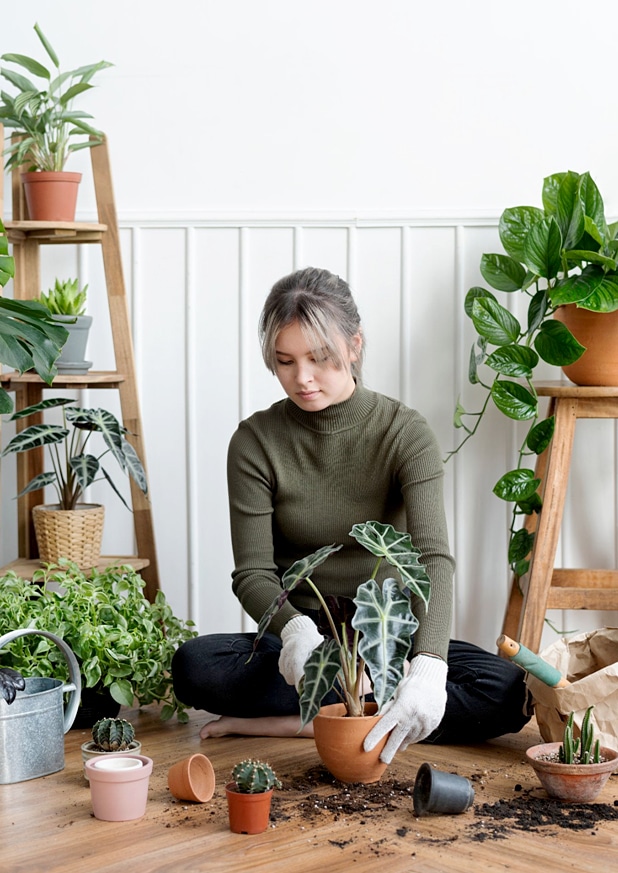

How to repot plants can be daunting, especially if you are a beginner. Luckily, we have a few tips to help make it a success. From choosing the right pot and soil, and giving you a straightforward step-by-step process, this article has you covered. Let’s dive in.
Look at the pot’s bottom. If the roots are coming out of the drainage hole, they have outgrown the current pot; hence, the plant needs repotting to have more room to thrive. Roots can also circle at the bottom or top of the pot. It is another sign you need to repot your houseplant.
When roots outgrow the pot, they lose their effectiveness. They will not take up crucial nutrients and water. And if they are entangled, they will inhibit smooth water flow. As such, the plant will gradually be deprived of nutrients, leading to ultimate death.
A houseplant that suddenly starts losing its leaves could be a sign it needs repotting. Leaves play a crucial role in the survival of a houseplant. Thanks to chlorophyll, they provide the plant with energy. Without them, the plant will have stunted growth.
When the roots come out of the pot or are bound together, your houseplant responds by shedding more leaves than usual. Once you rule out diseases and underwatering, it’s time to repot it.
There are several causes of drooping leaves. If you underwater the houseplant, the leaves will gradually droop since they are not taking up enough water. Likewise, the plant might have excess water if you overwater, causing the leaves to wilt. If neither of the above is the cause of the leaves wilting, it’s a sign you need to repot your houseplant.
While several pot issues cause drooping, the common source is problems with the root system. When the roots cannot take up ample water and nutrients, the stem, branches, and leaves will not receive adequate water, causing the leaves to droop. Once you repot the houseplant in a larger pot, the plant will gradually regain its strength.
Yellowing leaves are among the top houseplant problems. Many factors cause leaves to turn yellow, including inadequate sunlight, overwatering, underwatering, and diseases. One overlooked cause is the plant outgrowing the pot, warranting repotting.
Generally, yellowing leaves are a sign of nutrient-deficient soil. While fertilizing may solve the problem, it will be short-lived, especially if the plant has been sitting in the same pot for many years. The only solution is to repot your houseplant. The new soil will hold nutrients, allowing the plant to take up as much as it needs.
It might be hard to identify a houseplant that is not growing since they tend to grow slowly. However, if it is clear it has stopped growing, it’s time to repot. As you’d guess, most houseplants are from the tropical family, growing in nutrient-rich soils. In fact, if left in the wild, they can grow to massive heights, such as trailing pothos.
While the confines of a pot do not meet such standards, the houseplant still grows, although slowly. Therefore, if your houseplant has stunted growth, you must use a larger pot. Stunted growth leads to many problems and death in the worst case.
Before you begin repotting your plant, ensure you have the following tools:
Here are repotting plants tips you should follow:
Without pulling the plant, turn the pot sideways, gently holding the stem, and tap at the pot’s bottom until it slides out. You might be forced to rotate the plant gently in both directions for it to loosen. You can also use a trowel or sharp knife to separate the houseplant and the pot.
Use your hands to loosen the rootball. Remove old roots that have outgrown the core rootball. Once you remove them, untangle the healthy roots so they can grow outward.
Remove a third of the old potting mix. It is because it is deprived of nutrients, and the plant needs to fit in the pot with the new potting mix.
Finally, hold your plant upright and press it firmly into the new pot. Add a layer of fresh soil around the plant until it is secure. Finally, water to allow it to settle.
Typical houseplants require repotting every 12 to 18 months, depending on their growth rate. Slow growers such as snake plants or jade plants can sit in the same pot for many years. However, you need to replenish the soil with ample nutrients such as fertilizers.
The best season to repot your plant is early spring and late summer. Plants tend to grow actively during this period, requiring more space and nutrients.
Wait for up to seven days to water a repotted plant. The seven days period allows any damaged roots during repotting to heal. Ensure to keep the plant in a shadier and cooler spot to avoid unnecessary stress.
There are several repotting purposes among them:
Besides improving the houseplant’s health, repotting can beautify your spaces. For example, you can remove a plant from a boring container into a much more appealing one, which complements the aesthetic aspect of its surroundings.
As they grow larger, most houseplants afford you the luxury of dividing them into smaller ones. Each section is therefore planted in a new pot. As such, you’ll have many houseplants from the parent plant. You can then place the new pots in different rooms.
Often, diseases and pests infest soil, depriving it of its nutrients. It means you need to provide fresh soil that is rich in nutrients. This is where repotting comes in handy. You can remove the poor old soil, thoroughly clean the pot, and pour in the new soil. Alternatively, you can use a new pot altogether.
Another reason for repotting is to provide the houseplant with a larger growing space. As mentioned, houseplants outgrow their pots, causing the roots to grow outside the pot. It leads to stunted growth or death. Moving the plant to a larger pot allows the roots to grow, enabling the plant to thrive.
How to repot plants can be daunting, especially for novice growers. Roots can be damaged, and the rootball may disintegrate. Luckily, a release pot makes repotting a walk in the park.
The modular design lets you release the plant seamlessly into a new pot with the rootball intact. Call us or visit our shop to get one today.
